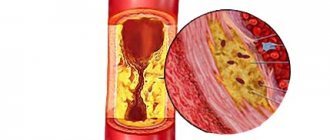The group of cardiovascular diseases (CVD) occupies a leading position in the structure of causes of disability and mortality. Every year the number of patients with pathologies of the heart and blood vessels increases. This is primarily due to poor lifestyle, stress and other reasons. Cardiovascular risk is the likelihood of developing adverse outcomes.
Taking into account risk factors for cardiovascular diseases when choosing optimal preventive measures was proposed back in 1988 by American cardiologists. Later, scientists and doctors developed special tables that allow one to determine the risk of death from CVD in the next 10 years.
Risk of Cardiovascular Diseases
What are cardiovascular diseases?
Cardiovascular diseases are a group of diseases of the heart and blood vessels that include:
- coronary heart disease - a disease of the blood vessels that supply blood to the heart muscle;
- cerebrovascular disease - a disease of the blood vessels that supply blood to the brain;
- Peripheral artery disease - disease of the blood vessels that supply blood to the arms and legs;
- rheumatic carditis - damage to the heart muscle and heart valves as a result of a rheumatic attack caused by streptococcal bacteria;
- congenital heart disease – deformations of the structure of the heart existing from birth;
- Deep vein thrombosis and pulmonary embolism - the formation of blood clots in the leg veins that can dislodge and move towards the heart and lungs.
Heart attacks and strokes are usually acute illnesses and occur primarily as a result of blockages in blood vessels that prevent blood from flowing to the heart or brain. The most common cause of this is the formation of fatty deposits on the inner walls of the blood vessels that supply blood to the heart or brain. Bleeding from a blood vessel in the brain or blood clots can also cause a stroke. Myocardial infarction and stroke are usually caused by a combination of risk factors such as tobacco use, unhealthy diet and obesity, physical inactivity and harmful use of alcohol, high blood pressure, diabetes and hyperlipidemia.
Age over 45 years
Not all risk factors for developing diseases of the cardiovascular system can be controlled by a person and adjusted through lifestyle changes. Some of them, such as age over 45, sooner or later overtake the patient. This risk factor is due to the fact that by this period of life the cardiovascular system is already beginning to gradually wear out. Those compensatory capabilities of the body that previously protected the heart and blood vessels begin to deplete. As a result, the risk of developing all kinds of pathologies of these structures increases significantly.
What are the risk factors for cardiovascular disease?
The main risk factors for heart disease and stroke are poor diet, physical inactivity, tobacco use and harmful use of alcohol.
The effects of behavioral risk factors on an individual may include increased blood pressure, increased blood glucose, increased blood lipids, and overweight and obesity. These “intermediate risk factors” can be assessed in primary care settings and may indicate an increased risk of myocardial infarction, stroke, heart failure and other complications.
Quitting tobacco use, reducing salt intake, consuming fruits and vegetables, regular physical activity and avoiding harmful use of alcohol have been shown to reduce the risk of developing cardiovascular disease. In addition, drug therapy may be necessary to reduce the risk of CVD and prevent heart attack and stroke in people with diabetes, high blood pressure, and elevated lipid levels. To increase people's motivation to make and maintain healthy behaviors, health policies are needed to create an enabling environment for healthy choices to be made and afforded to them.
In order for people to choose and maintain healthy behaviors, policies are needed to create an environment conducive to healthy choices, their accessibility and affordability.
There are also a number of factors that influence the development of chronic diseases, or underlying causes. They reflect the main driving forces leading to social, economic and cultural changes - globalization, urbanization and population aging. Other determinants of CVD include poverty, stress and genetic factors.
Ways to limit the influence of harmful factors
Naturally, it is impossible to change age, gender and heredity. But the adverse effects of other risk factors can be avoided through lifestyle changes. The patient should give up bad habits, especially smoking and alcohol abuse. In this case, replacing tobacco with an electronic cigarette will not help, since the latter also contains nicotine, sometimes even in greater quantities than regular cigarettes.
An extremely important point in eliminating the main risk factors is changing a person’s gastronomic behavior. He should stop overeating and eat less of various seasonings that contain large amounts of table salt. In addition, you should not overuse foods that are too fatty. We are talking about those of animal origin. It is these foods that can significantly increase cholesterol levels in the blood.
Of course, you should not neglect physical exercise. Morning exercises, periodic trips to the gym and walking in the evenings will help avoid physical inactivity.
If all these rules are followed, the risk of developing dangerous diseases will undoubtedly decrease, including those that affect the heart and blood vessels.
What are the common symptoms of cardiovascular disease?
Symptoms of heart attack and stroke
Often the underlying blood vessel disease is asymptomatic. A heart attack or stroke may be the first warning sign of the disease. Symptoms of a heart attack include:
- pain or discomfort in the middle of the chest;
- pain or discomfort in the arms, left shoulder, elbows, jaw or back.
In addition, the person may experience difficulty breathing or shortness of breath; nausea or vomiting; feel dizzy or faint; break out in a cold sweat and become pale. Women are more likely to experience shortness of breath, nausea, vomiting, and back and jaw pain.
The most common symptom of a stroke is sudden weakness in the face, most often on one side, arm or leg. Other symptoms include sudden numbness of the face, especially on one side, arms or legs; confusion; difficulty speaking or difficulty understanding speech; difficulty seeing in one or both eyes; difficulty walking, dizziness, loss of balance or coordination; severe headache for no specific reason, as well as loss of consciousness or unconsciousness.
People experiencing these symptoms should seek medical help immediately.
What is rheumatic carditis?
Rheumatic heart disease is damage to the heart valves and heart muscle due to inflammation and scarring caused by rheumatic fever. Rheumatic fever is caused by an abnormal response of the body to a streptococcal infection. The disease usually first manifests itself as a sore throat or tonsillitis in children.
Rheumatic fever primarily affects children in developing countries, especially in settings where poverty is widespread. Worldwide, rheumatic carditis is associated with almost 2% of all deaths from cardiovascular diseases.
Symptoms of rheumatic carditis
- Symptoms of rheumatic heart disease include: shortness of breath, fatigue, irregular heartbeats, chest pain and loss of consciousness.
- Symptoms of rheumatic fever include: fever, joint pain and swelling, nausea, stomach cramps and vomiting.
How can the burden of cardiovascular disease be reduced?
For the prevention and control of cardiovascular disease, WHO has identified a number of “best buys,” or highly cost-effective interventions that are feasible even in low-resource settings. They include 2 types of interventions—population-based and individual-level interventions—that can be used in combination to reduce the high burden of cardiovascular disease.
Examples of interventions that can be implemented to reduce CVD at a national level include the following:
- comprehensive tobacco control policies;
- taxation to reduce consumption of foods high in fat, sugar and salt;
- building walking and cycling paths to increase physical activity levels;
- strategies to reduce the harmful use of alcohol;
- ensuring proper nutrition for children in schools.
To prevent first myocardial infarctions and strokes, individual health interventions should target individuals with moderate or high overall cardiovascular risk or those with individual risk factors such as diabetes, hypertension and hypercholesterolemia above recommended levels. carrying out treatment.
The former (an integrated approach that takes into account all risk factors) is more cost-effective than the latter and can significantly reduce the incidence of cardiovascular events. This approach is feasible in low-resource settings, including the use of non-physician medical personnel.
For secondary prevention of CVD in people with pre-existing disease, including diabetes, treatment with the following medications is necessary:
- aspirin;
- beta blockers;
- angiotensin-converting enzyme inhibitors;
- statins.
The positive results obtained are largely unrelated, but when used in combination with smoking cessation, almost 75% of recurrent vascular events can be prevented. There are currently significant gaps in the implementation of these measures, especially at the primary health care level.
In addition, treatment of CVD sometimes requires expensive surgery. These include:
- coronary artery bypass grafting;
- balloon angioplasty (in which a small balloon catheter is inserted through an artery to restore lumen to a blocked vessel);
- plastic and valve replacement;
- heart transplant;
- operations using an artificial heart.
Some CVDs require medical devices to treat. These devices include pacemakers, artificial valves, and patches to close holes in the heart.
National Society for the Study of Atherosclerosis
Risk of developing cardiovascular diseases
There are two scales for assessing the risk of CVD - a scale based on the results of the Framingham study, which allows you to calculate the 10-year risk of major coronary events (death from coronary artery disease, non-fatal myocardial infarction) and the SCORE (Systematic Coronary Risk Evaluation) scale, which makes it possible to determine 10 -yearly risk of fatal cardiovascular events.
The SCORE score is designed to guide primary prevention strategies in a European population. It takes into account the risk of not only coronary heart disease, but also all cardiovascular events, taking into account coronary and non-coronary risk factors. To assess the risk of developing CVD, it is most optimal to use the SCORE scale, which is given in the European recommendations for the prevention of CVD [1].
SCORE Risk Assessment System
All indicated indicators of this system were calculated based on data from 12 European epidemiological studies. The system is presented in two tables for calculating risk in countries with low and high levels of risk. In addition to color division by risk level, each cell of the graph contains a number for a more accurate quantitative risk assessment. The risk indicator is the probability of death from any CVD in the next 10 years of the patient’s life. A high risk is considered to be 5% or more.
Priority groups of patients for the prevention of CVD (European recommendations 2003) [1]:
- Patients with manifestations of coronary, peripheral or cerebral atherosclerosis.
- Patients without CVD symptoms but at high risk of developing fatal vascular events due to:
- a combination of several risk factors (probability of developing fatal vascular events in the next 10 years ≥ 5%)
- significantly expressed single risk factors (TC ≥ 8 mmol/l, LDL cholesterol ≥ 6 mmol/l)
- Blood pressure ≥ 180/110 mm Hg. Art.
- diabetes mellitus type 2 or type 1 with microalbuminuria.
- Close relatives of patients with early development of CVD.
Below are color tables for calculating CVD risk. They take into account the patient’s gender, age, total cholesterol level, blood pressure, and smoking. Green indicates low risk, dark brown indicates high risk (Table 3).
Table 3. Table of 10-year fatal risk of CVD (European Society of Cardiology, 2003 (12 European cohorts, including Russia))
It should be noted that the CVD risk calculated using SCORE may be underestimated if:
- Examination of an elderly patient
- Preclinical atherosclerosis
- Unfavorable heredity
- Decrease in HDL cholesterol, increase in TG, CRP, apoB/Lp(a)
- Obesity and physical inactivity.
Criteria based on which the severity of CVD risk is determined
High risk: the presence of 2 or more risk factors in combination with coronary artery disease (myocardial infarction, unstable angina, stable angina, previous coronary artery bypass surgery or transluminal coronary angioplasty, documented clinically significant myocardial ischemia). High risk also includes the presence of 2 or more risk factors in combination with diseases equivalent in risk to coronary artery disease: peripheral atherosclerosis of the lower extremities, aortic aneurysm, atherosclerosis of the carotid arteries (transient ischemic attack or stroke due to damage to the carotid arteries or narrowing of the lumen of the carotid artery >50%), diabetes mellitus. The risk of developing severe ischemic heart disease within 10 years is > 20%.
Moderately high risk: the presence of 2 or more risk factors. The risk of developing severe ischemic heart disease within 10 years is 10-20%.
Moderate risk: presence of 2 or more risk factors. The risk of developing severe ischemic heart disease within 10 years is <10%.
Low risk: 0-1 risk factor. Assessing the risk of coronary artery disease in this group is not necessary.
The main risk factors that influence target LDL cholesterol levels are (NCEP ATP III) [2]:
- Smoking cigarettes
- Hypertension (BP more than 140/90 mm Hg) or antihypertensive therapy
- Low HDL cholesterol (<40 mg/dL)
- Early development of coronary heart disease in a family history (1st degree of relationship; up to 55 years in men, up to 65 years in women)
- Age (men over 45 years old, women over 55 years old)
It should be noted that the so-called new lipid and non-lipid risk factors are now generally recognized: New lipid risk factors:
- Triglycerides
- Lipoprotein remnants
- Lipoprotein(a)
- Small LDL particles
- HDL subtypes
- Apolipoproteins: B and A-I
- Ratio: LDL-C/HDL-C
New non-lipid risk factors:
- Homocysteine
- Thrombogenic/antithrombogenic factors (platelet and coagulation factors, fibrinogen, activated factor VII, plasminogen activation inhibitor-1, tissue plasminogen activator, von Willebrand factor, factor V Leiden, protein C, antithrombin III)
- Inflammatory factors
- Increased fasting glucose levels
Levels of cholesterol, LDL cholesterol, and HDL cholesterol can also be used to determine the risk of CVD (Table 4).
Table 4. Determination of CVD risk based on lipid profile LDL cholesterol (mmol/l)
| LDL cholesterol (mmol/l) | |
| <2.6 | Optimal |
| 2.6-3.4 | Close to optimal |
| 3.4-4.1 | Borderline high |
| 4.1-4.9 | High |
| >4.9 | Very tall |
| Total cholesterol (mmol/l) | |
| <5.2 | Desirable |
| 5.2-6.2 | Borderline high |
| >6.2 | High |
| HDL cholesterol (mmol/l) | |
| <1.0 | Short |
| >1.55 | High |
The European guidelines for the prevention of CVD consider the management of patients without clinical manifestations of coronary artery disease and other CVD, which is based on the calculation of the risk category (Fig.  [23]:
[23]:
Figure 8. Management tactics for patients without clinical manifestations of coronary artery disease and other CVDs, based on calculation of risk category
Thus, calculation of the risk for a specific patient must be made in all cases. Accordingly, recommendations and treatment tactics should be developed taking into account risk, since this approach reduces the likelihood of CVD and its complications.
Bibliography
- EUROPEAN GUIDELINES ON CVD PREVENTION Third joint European societies' task force on cardiovascular disease prevention in clinical practice, 2003
- NCEP ATPIII:JAMA, May 16, 2001, 285(19), p.2486-97
WHO activities
Under WHO's leadership, in 2013, all Member States (194 countries) agreed on global frameworks to reduce the burden of preventable NCDs, including the Global Action Plan for the Prevention and Control of NCDs 2013–2020. The plan aims to reduce premature deaths from NCDs by 25% by 2025 through 9 voluntary global targets. 2 of these global goals directly address the prevention and control of CVDs.
Goal six of the Global NCD Action Plan aims to reduce the global prevalence of high blood pressure by 25%. High blood pressure is one of the main risk factors for cardiovascular disease. The global prevalence of high blood pressure (defined as systolic and/or diastolic pressure ≥140/90 mmHg) among people aged 18 years and over in 2014 was about 22%.
To achieve this goal, it is necessary to reduce the incidence of hypertension through national policies that address behavioral risk factors, including harmful use of alcohol, physical inactivity, overweight, obesity and high salt intake. Early detection and cost-effective management of hypertension to prevent myocardial infarction, stroke, and other complications requires a risk-based approach.
Goal eight of the Global NCD Action Plan aims to ensure that at least 50% of eligible people receive drug therapy and counseling (including glycemic control) to prevent myocardial infarction and stroke. Preventing heart attack and stroke using a comprehensive approach that takes into account overall cardiovascular risk is more cost-effective than treating based solely on individual risk factor thresholds and should be part of the core package of services to achieve universal health coverage. sanitary assistance. Achieving this goal will require strengthening key components of the health system, including financing health care services to ensure access to essential health technologies and essential medicines for NCDs.
In 2020, countries will begin setting national targets and measuring progress against the 2010 baselines set out in the Global Noncommunicable Disease Status Report 2014. The UN General Assembly will hold its third high-level meeting on NCDs in 2020 to review countries' progress towards achieving the voluntary global targets by 2025.
Causes of CVD development
Damages of the heart and blood vessels are multifactorial pathologies - they arise against the background of several predisposing conditions. The main cause of the vast majority of cardiac and cerebrovascular pathologies is an increase in the level of low-density lipoproteins (LDL) in the blood. An increase in their concentration leads to excess cholesterol, which forms plaques on the walls of blood vessels, narrowing their lumen.
An important role in the development of CVD is played by hereditary predisposition - those at risk are those whose immediate relatives (brothers, sisters, parents) have the corresponding disease. The likelihood of developing cardiovascular pathologies is increased by diabetes mellitus, kidney and thyroid diseases, infections (most often streptococcal - sore throat, scarlet fever, erysipelas, impetigo). In women, the triggering factor is conditions accompanied by hormonal changes: more often - menopause, less often - pregnancy.
The leading risk factors include lifestyle features and their adverse consequences:
- Physical inactivity. A sedentary lifestyle negatively affects the condition of the vascular walls and myocardium, increases the risk of thrombosis, and contributes to the occurrence of excess weight and diabetes.
- Diet errors. Increased salt consumption increases the risk of hypertension, excess sweets in the diet leads to diabetes, obesity, and increases LDL levels. Abuse of animal fats contributes to the development of atherosclerosis. Lack of proteins, microelements (potassium, magnesium, iron, copper, zinc, selenium), most vitamins negatively affects the condition of blood vessels and the heart, and myocardial function.
- Psycho-emotional stress. Acute stress is accompanied by the release of adrenaline, which increases the load on the heart, which can lead to myocardial infarction. Chronic stress is accompanied by increased levels of cortisol, which slows down the production of growth hormone. Deficiency of this hormone in adults indirectly provokes the development of CVD.
- Excess body weight is usually a consequence of the influence of the factors listed above. Obesity is a favorable condition for the occurrence of thromboembolism, increases LDL levels, and creates additional stress on the heart and blood vessels.
- Bad habits. Each episode of alcohol abuse leads to a decrease in the contractile function of the myocardium and impairs blood circulation. Tobacco smoking leads to increased blood pressure, provokes blood clots, the formation of atherosclerotic plaques, and increases the risk of arrhythmia.
Often one primary CVD leads to the development of another. Thus, atherosclerosis and arterial hypertension are the main causes of coronary heart disease, rheumatic carditis often leads to acquired defects, cardiac arrhythmias, and heart rhythm disturbances lead to thromboembolism of the arteries supplying blood to the limbs and internal organs.











